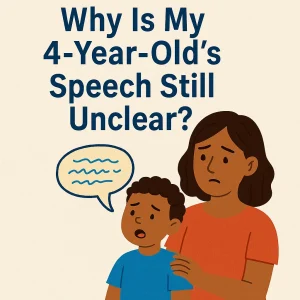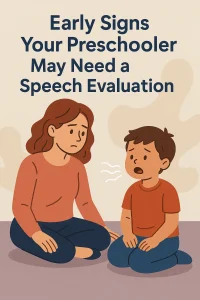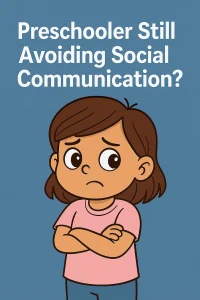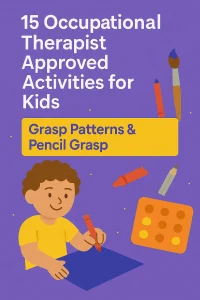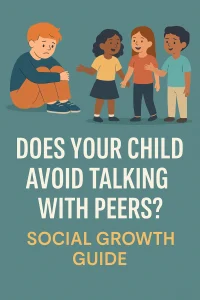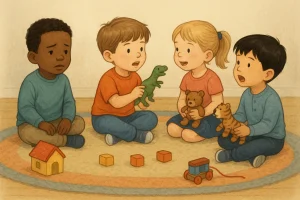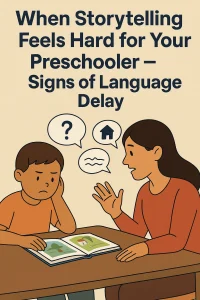5 Simple Tips to Support Your Baby’s Speech & Language Growth
Last Updated: June 5, 2025
As parents, we all want the best for our little ones, especially when it comes to their growth and development. One crucial area that often worries new parents is baby speech and language growth. Did you know that your baby starts learning language skills right from birth? It’s true! The early months and years are vital for laying the foundation for effective communication.
The good news is that you don’t need special tools or complicated routines to support baby speech and language growth. Simple, everyday activities can make a significant impact. By incorporating easy practices into your daily routine, you can help boost your baby’s communication skills in fun and engaging ways.
Free Speech Help for Kids
Concerned about speech delays? Book a free consultation with our expert speech therapist and get guidance tailored to your child’s needs.
1. Talk to Your Baby Face-to-Face
Why It’s Important: From the moment your baby is born, they start learning about the world around them through listening and observing. Early language development begins right from birth, and the simple act of talking to your baby plays a crucial role in their speech and language growth. When you speak to your baby face-to-face, you’re not only helping them understand the sounds and rhythms of speech, but you’re also teaching them the basics of communication, like making eye contact and reading facial expressions.
How to Do It: Talking to your baby doesn’t require any special skills or preparation. It’s about integrating speech into your everyday activities. Narrate what you’re doing, what you see, and how you feel. Describe your actions and the environment around you. This constant verbal interaction helps build your baby’s vocabulary and comprehension skills.
Example: Imagine you’re in the kitchen preparing lunch. You could say, “Mommy is chopping carrots. Look at the orange color! Now I’m putting them in the pot to cook. Can you hear the water boiling?” This type of narration not only introduces your baby to new words but also helps them understand the context in which these words are used.
Also Read: Understanding Baby Talk: Is It Good or Bad for Child Growth?
2. Respond to Your Baby’s Sounds
Why It’s Important: When your baby starts cooing, squealing, and babbling, they’re beginning to explore their vocal abilities. Responding to these sounds is crucial because it encourages vocal play and helps your baby understand that sounds have meanings. These early vocal interactions lay the foundation for future speech and language development, teaching your baby the basics of communication like taking turns in a conversation.
How to Do It: Engaging with your baby’s sounds is simple and enjoyable. Mimic their noises and respond to their coos and babbles. This back-and-forth interaction is not only fun but also educational. Your baby learns that their sounds can elicit responses, reinforcing the idea that communication is a two-way street.
Example: Imagine your baby coos while lying in their crib. You can respond by mimicking the sound or saying something like, “Yes, I hear you! Tell me more.” These interactions might seem small, but they are powerful in teaching your baby the art of conversation.
3. Play with Toys and Incorporate Social Games
Why It’s Important: Playtime is not just fun; it’s also a crucial part of your baby’s speech and language development. Through play, babies learn to explore their environment, understand cause and effect, and develop their communication skills. Engaging with toys and social games helps babies make sense of the world around them, which is highly correlated with their speech and language growth.
How to Do It: Incorporate toys that make sounds or have bright colors to catch your baby’s attention. These toys can help stimulate your baby’s senses and encourage them to interact. Simple social games like peek-a-boo or patty cake are also fantastic for promoting language development and social skills.
Example: To make the most of playtime, try this: Hold a brightly colored toy near your face and move it slowly from side to side. This encourages your baby to follow the toy with their eyes, promoting visual tracking and attention. As your baby watches the toy, talk to them about what’s happening: “Look at the red ball! It’s moving side to side. Can you see it?”
Games like peek-a-boo are excellent for teaching your baby about object permanence and turn-taking, both of which are essential for language development. You can play by covering your face with your hands or a small blanket and then revealing it, saying, “Peek-a-boo! I see you!” This simple game helps your baby learn that things and people still exist even when they can’t see them.
Know more: Effective Speech Therapy at Home: Top Techniques for Kids
4. Read Books Together
Why It’s Important: Reading to your baby is one of the most powerful ways to support their speech and language growth. It exposes them to new words and concepts, fostering their language skills and cognitive development. Through books, babies learn about the world, expand their vocabulary, and develop a love for reading that can last a lifetime.
How to Do It: Choose books with big, bright pictures, rhyming words, and repetitive phrases. These features are engaging for babies and help reinforce language patterns. Make reading a part of your daily routine, whether it’s during bedtime, nap time, or any quiet moment.
Example: During bedtime, you might read “Goodnight Moon.” As you read, point out the objects on the pages, saying things like, “Look, there’s a little bunny. Can you see the moon?” This not only makes the reading session interactive but also helps your baby connect words with objects.
Another great way to engage your baby is by varying your tone of voice and using different expressions. This keeps your baby interested and helps them understand the emotions behind the words. Books with repetitive phrases, like “Brown Bear, Brown Bear, What Do You See?” are particularly effective because they help babies anticipate what comes next and learn through repetition.
Read more: 6 Amazing Children’s Books for Speech and Language Growth
Types of Books to Read
| Type of Book | Features | Examples |
|---|---|---|
| Picture Books | Big, bright pictures | “Goodnight Moon” |
| Rhyming Books | Rhyming words and patterns | “Brown Bear, Brown Bear, What Do You See?” |
| Repetitive Phrases | Repetitive sentences and phrases | “The Very Hungry Caterpillar” |
| Interactive Books | Touch and feel, flaps to lift | “Where’s Spot?” |
| Sound Books | Embedded sounds and music | “Listen and Learn: Farm Animals” |
| Bilingual Books | Texts in two languages | “First 100 Words Bilingual” |
5. Sing Songs
Why It’s Important: Singing to your baby is a wonderful way to support their speech and language growth. Music helps babies develop listening and comprehension skills, which are foundational for language development. The melodies and rhythms of songs make it easier for babies to pick up on words and phrases, aiding their understanding and memory.
How to Do It: Incorporate simple, repetitive songs and nursery rhymes into your daily routine. These songs are not only fun but also educational, helping your baby become familiar with language patterns and sounds. You can sing during playtime, bath time, or even while rocking your baby to sleep.
Example: During playtime or bath time, sing “Twinkle, Twinkle, Little Star” to your baby. The repetitive nature of the song and its soothing melody make it a great choice for engaging your baby and boosting their language skills. You can sing: “Twinkle, twinkle, little star, How I wonder what you are. Up above the world so high, Like a diamond in the sky.”
As you sing, make eye contact with your baby and use hand gestures to illustrate the words. For instance, twinkle your fingers when you say “twinkle” or point up when you sing “up above the world so high.” These visual cues reinforce the words and make the experience more interactive and enjoyable for your baby.
Songs and Rhymes for Babies
| Song Title | Why It’s Beneficial |
|---|---|
| “Twinkle, Twinkle, Little Star” | Simple, repetitive lyrics help babies recognize patterns in language and develop memory skills. |
| “Wheels on the Bus” | Engages babies with actions, promoting coordination and understanding of sequences and routines. |
| “Itsy Bitsy Spider” | Encourages hand movements, which aids in developing fine motor skills and hand-eye coordination. |
| “Row, Row, Row Your Boat” | Simple melody and repetitive lyrics make it easy for babies to learn and follow along, enhancing language skills. |
| “Old MacDonald Had a Farm” | Introduces animal sounds and names, expanding vocabulary and comprehension. |
| “Head, Shoulders, Knees, and Toes” | Teaches body parts and promotes physical activity, helping with language and motor development. |
Conclusion
Let’s recap the five simple tips to support baby speech and language growth. First, talk to your baby face-to-face by narrating your daily activities. Second, respond to your baby’s sounds to encourage vocal play. Third, play with toys and incorporate social games like peek-a-boo. Fourth, read books together with big, bright pictures and repetitive phrases. Fifth, sing simple, repetitive songs and nursery rhymes to your baby. These tips are easy to integrate into your daily routine and are highly effective in helping your baby learn to communicate.
These activities are not just about teaching your baby to speak but also about bonding and making wonderful memories together. By doing these things every day, you’re helping your baby develop strong language skills. Remember, the key is to be consistent and make these activities a natural part of your day. For more tips and support, visit Wellness Hub. We’re here to help you feel confident and equipped in nurturing your baby’s growth and development.
Frequently Asked Questions:
1. How can I support my baby’s speech and language development?
You can support your baby’s speech and language development by talking to them face-to-face, responding to their sounds, playing with toys and social games, reading books together, and singing songs. These activities are simple to integrate into your daily routine and can significantly boost your baby’s communication skills.
2. What are some tips for helping my baby’s speech grow?
Some tips for helping your baby’s speech grow include narrating your daily activities, mimicking and responding to their coos and babbles, using colorful and noisy toys, reading books with bright pictures and repetitive phrases, and singing nursery rhymes and songs.
3. How can I boost my baby’s language skills?
Boost your baby’s language skills by engaging them in conversations, playing interactive games like peek-a-boo, reading regularly, and singing songs. These activities help expose your baby to new words and concepts in a fun and engaging way.
4. What activities help with baby speech development?
Activities that help with baby speech development include talking to your baby throughout the day, responding to their sounds, playing with toys, reading books, and singing songs. These activities encourage vocal play and help babies understand the meaning of sounds and words.
5. How can I encourage my baby to talk more?
Encourage your baby to talk more by having frequent face-to-face conversations, responding enthusiastically to their sounds, incorporating interactive play, reading together, and singing repetitive songs. Consistent engagement in these activities can foster a love for communication in your baby.
6. What are the best methods for encouraging baby language growth?
The best methods for encouraging baby language growth include talking to your baby, responding to their vocalizations, engaging in play, reading books with vibrant images, and singing nursery rhymes. These methods help create a rich language environment that supports your baby’s development.
7. How can I make reading to my baby more effective?
Make reading to your baby more effective by choosing books with big, bright pictures, rhyming words, and repetitive phrases. Point out objects and describe them as you read. Vary your tone of voice and use expressions to keep your baby engaged and interested.
8. What songs are good for baby language development?
Good songs for baby language development include “Twinkle, Twinkle, Little Star,” “Wheels on the Bus,” and “Itsy Bitsy Spider.” These songs have simple, repetitive lyrics that help babies learn language patterns and develop their listening skills.
9. Why is playing with toys important for speech development?
Playing with toys is important for speech development because it helps babies explore their environment and learn about cause and effect. Toys that make sounds or have bright colors can stimulate your baby’s senses and encourage interaction, which is key for developing communication skills.
10. How often should I read to my baby to support language growth?
It’s beneficial to read to your baby every day. Incorporate reading into your daily routine, such as during bedtime or nap time, to expose your baby to new words and concepts regularly. This consistent practice helps foster a love for reading and supports language development.
About the Author:
Anuradha Karanam
Speech-language pathologist (7+ years of experience)
Anuradha Karanam is a skilled speech-language pathologist with over 6 years of experience. Fluent in Tamil, Telugu, Hindi, and English, she specializes in parent counseling, speech sound disorders, fluency assessment, and speech-language evaluations. Anuradha excels at working with children with developmental disorders, offering creative and effective therapy programs. Currently, at Wellness Hub, she holds a BASLP degree and is registered with the RCI (CRR No A85500). Her patience, ambition, and dedication make her a trusted expert in her field.
Book your Free Consultation Today
Parent/Caregiver Info:
Client’s Details:
* Error Message

